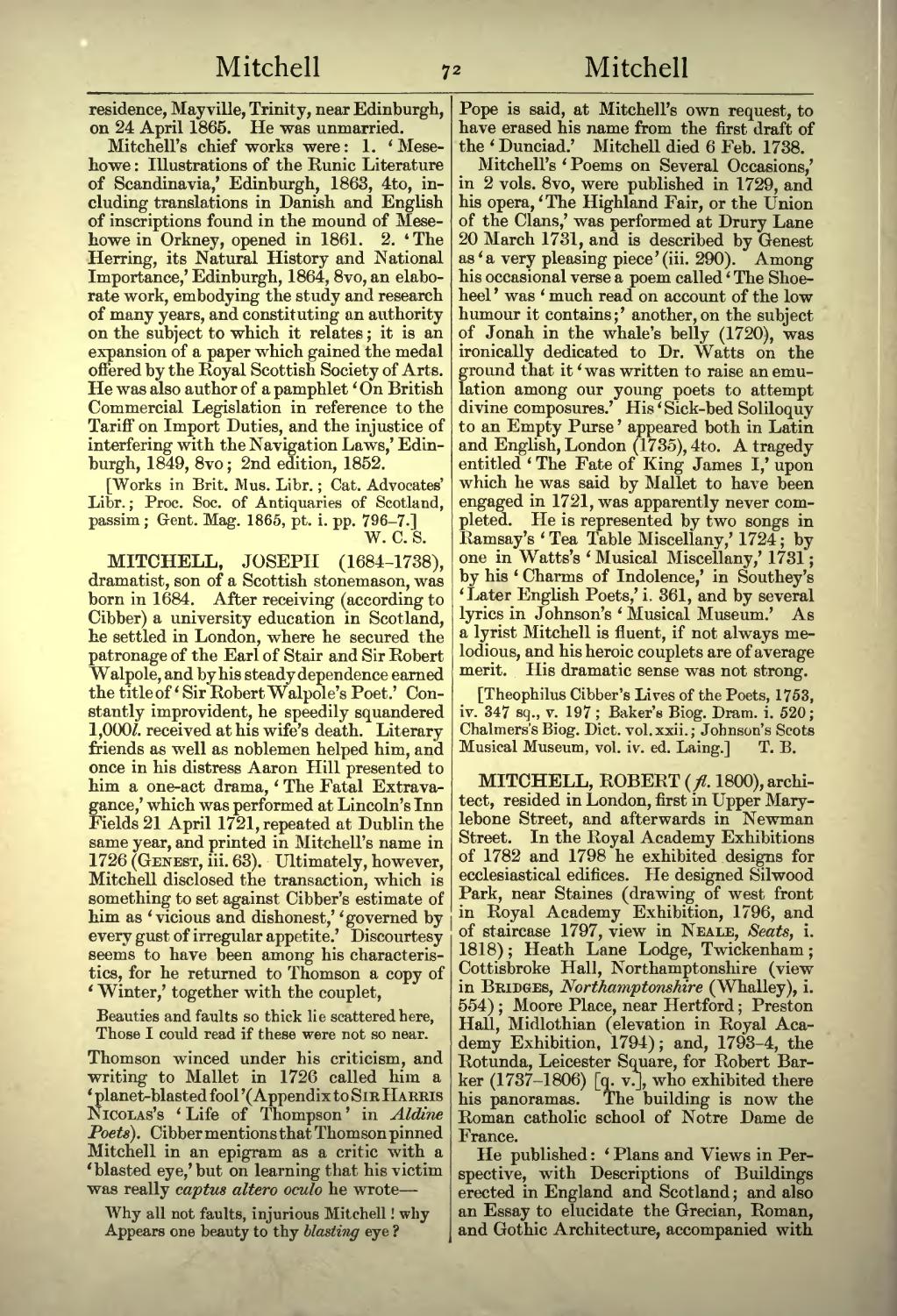residence, Mayville, Trinity, near Edinburgh, on 24 April 1865. He was unmarried.
Mitchell's chief works were: 1. 'Mesehowe: Illustrations of the Runic Literature of Scandinavia,' Edinburgh, 1863, 4to, including translations in Danish and English of inscriptions found in the mound of Mesehowe in Orkney, opened in 1861. 2. 'The Herring, its Natural History and National Importance,' Edinburgh, 1864, 8vo, an elaborate work, embodying the study and research of many years, and constituting an authority on the subject to which it relates; it is an expansion of a paper which gained the medal offered by the Royal Scottish Society of Arts. He was also author of a pamphlet 'On British Commercial Legislation in reference to the Tariff on Import Duties, and the injustice of interfering with the Navigation Laws,' Edinburgh, 1849, 8vo; 2nd edition, 1852.
[Works in Brit. Mus. Libr.; Cat. Advocates' Libr.; Proc. Soc. of Antiquaries of Scotland, passim; Gent. Mag. 1865, pt. i. pp. 796–7.]
MITCHELL, JOSEPH (1684–1738), dramatist, son of a Scottish stonemason, was born in 1684. After receiving (according to Cibber) a university education in Scotland, he settled in London, where he secured the patronage of the Earl of Stair and Sir Robert Walpole, and by his steady dependence earned the title of 'Sir Robert Walpole's Poet.' Constantly improvident, he speedily squandered 1,000l. received at his wife's death. Literary friends as well as noblemen helped him, and once in his distress Aaron Hill presented to him a one-act drama, 'The Fatal Extravagance,' which was performed at Lincoln's Inn Fields 21 April 1721, repeated at Dublin the same year, and printed in Mitchell's name in 1726 (Genest, iii. 63). Ultimately, however, Mitchell disclosed the transaction, which is something to set against Cibber's estimate of him as 'vicious and dishonest,' 'governed by every gust of irregular appetite.' Discourtesy seems to have been among his characteristics, for he returned to Thomson a copy of 'Winter,' together with the couplet,
Beauties and faults so thick lie scattered here,
Those I could read if these were not so near.
Thomson winced under his criticism, and writing to Mallet in 1726 called him a 'planet-blasted fool' (Appendix to Sir Harris Nicolas's 'Life of Thompson' in Aldine Poets). Cibber mentions that Thomson pinned Mitchell in an epigram as a critic with a 'blasted eye,' but on learning that his victim was really captus altero oculo he wrote—
Why all not faults, injurious Mitchell! why
Appears one beauty to thy blasting eye?
Pope is said, at Mitchell's own request, to have erased his name from the first draft of the 'Dunciad.' Mitchell died 6 Feb. 1738.
Mitchell's 'Poems on Several Occasions,' in 2 vols. 8vo, were published in 1729, and his opera, 'The Highland Fair, or the Union of the Clans,' was performed at Drury Lane 20 March 1731, and is described by Genest as 'a very pleasing piece' (iii. 290). Among his occasional verse a poem called 'The Shoe-heel' was 'much read on account of the low humour it contains;' another, on the subject of Jonah in the whale's belly (1720), was ironically dedicated to Dr. Watts on the ground that it 'was written to raise an emulation among our young poets to attempt divine composures.' His 'Sick-bed Soliloquy to an Empty Purse' appeared both in Latin and English, London (1735), 4to. A tragedy entitled 'The Fate of King James I,' upon which he was said by Mallet to have been engaged in 1721, was apparently never completed. He is represented by two songs in Ramsay's 'Tea Table Miscellany,' 1724; by one in Watts's 'Musical Miscellany,' 1731; by his 'Charms of Indolence,' in Southey's 'Later English Poets,' i, 361, and by several lyrics in Johnson's 'Musical Museum.' As a lyrist Mitchell is fluent, if not always melodious, and his heroic couplets are of average merit. His dramatic sense was not strong.
[Theophilus Cibber's Lives of the Poets, 1753, iv. 347 sq., v. 197; Baker's Biog. Dram. i. 520; Chalmers's Biog. Dict. vol.xxii.; Johnson's Scots Musical Museum, vol. iv. ed. Laing.]
MITCHELL, ROBERT (fl. 1800), architect, resided in London, first in Upper Marylebone Street, and afterwards in Newman Street. In the Royal Academy Exhibitions of 1782 and 1798 he exhibited .designs for ecclesiastical edifices. He designed Silwood Park, near Staines (drawing of west front in Royal Academy Exhibition, 1796, and of staircase 1797, view in Neale, Seats, i. 1818); Heath Lane Lodge, Twickenham; Cottisbroke Hall, Northamptonshire (view in Bridges, Northamptonshire (Whalley), i. 554); Moore Place, near Hertford; Preston Hall, Midlothian (elevation in Royal Academy Exhibition, 1794); and, 1793-4, the Rotunda, Leicester Square, for Robert Barker (1737–1806) [q. v.], who exhibited there his panoramas. The building is now the Roman catholic school of Notre Dame de France.
He published: 'Plans and Views in Perspective, with Descriptions of Buildings erected in England and Scotland; and also an Essay to elucidate the Grecian, Roman, and Gothic Architecture, accompanied with
